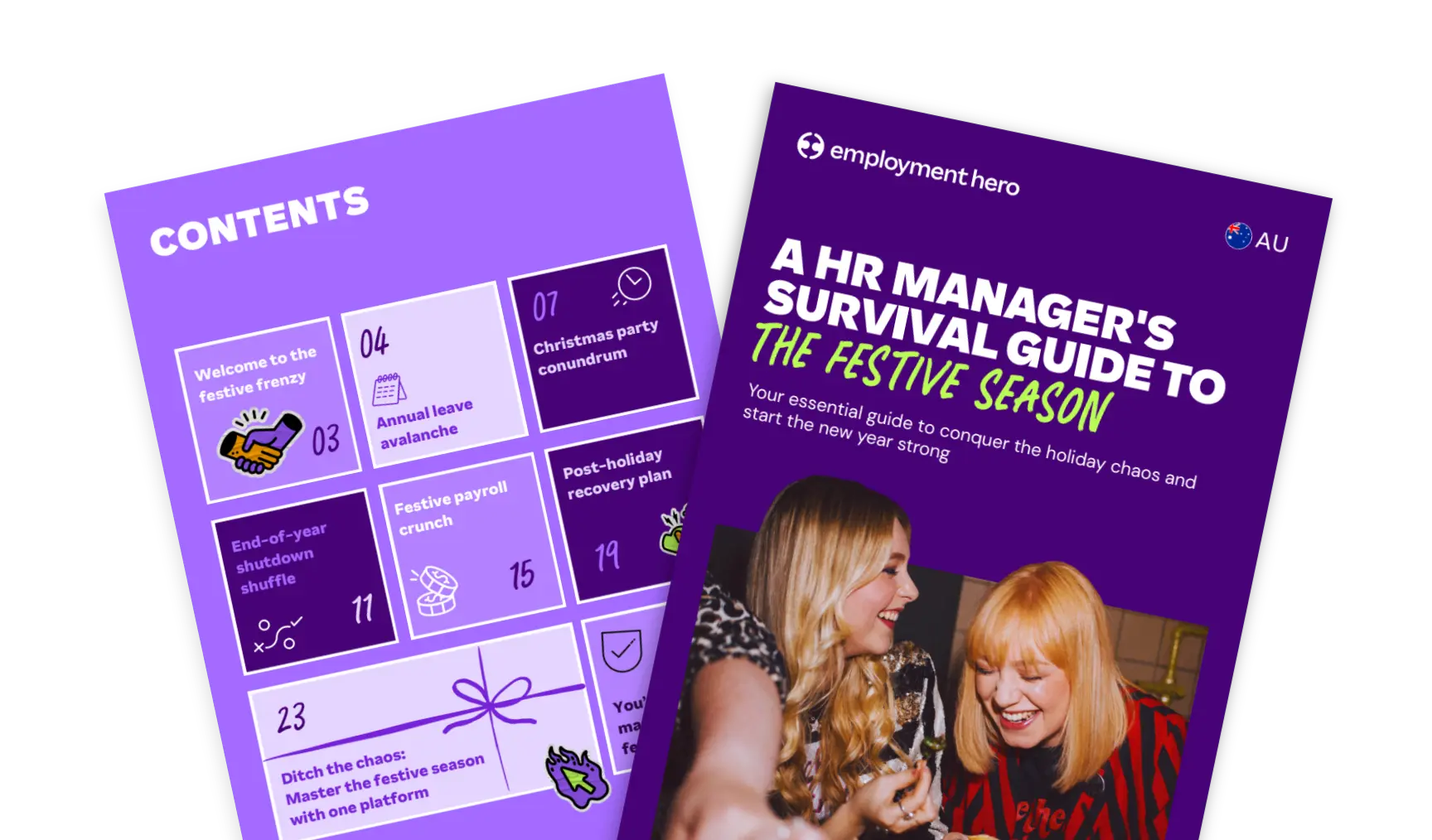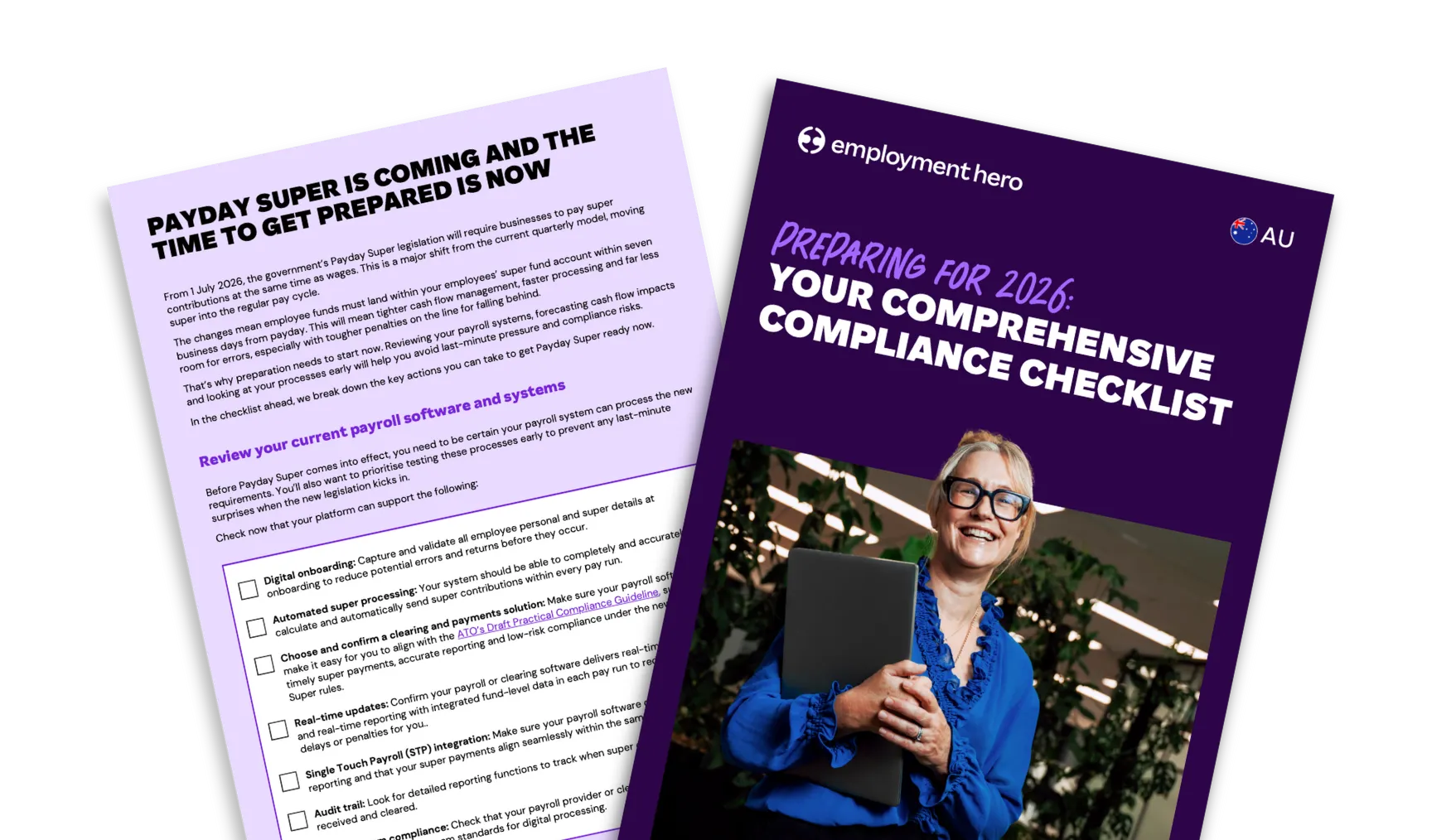Monthly business budget template for employers
Published
Monthly business budget template for employers
Published

Running a business means taking on more than a few roles. You’re the big-picture thinker, the manager, the problem-solver and sometimes even the one keeping an eye on the books. Balancing all of that isn’t easy, but getting your finances right is key to long-term success.
A solid business budget helps you do just that. It gives you a clear view of where your money’s going, helps you make confident decisions and turns financial management from a headache into a tool for growth.
Use this monthly budget template to plan, track and review your business’s financial performance. Each section includes tips to help you understand how your spending is tracking against your bottom line.
What’s included in this monthly budget template?
Our monthly business budget template gives you a complete, easy-to-follow view of your financial position. It’s designed to help you understand where your money comes from, where it goes and how to make smarter decisions each month. Here’s what you’ll find inside:
- Income and revenue: Track all income streams from sales, subscriptions, grants and more to see your actual earnings against your targets.
- Fixed expenses: List predictable monthly costs like rent, insurance, software and utilities.
- Variable expenses: Capture changing costs like marketing, travel, supplies and contractors.
- Wages and payroll costs: Track salaries, super, bonuses and training, i.e. your biggest investment.
- Other expenses: Record irregular costs like taxes, professional fees or maintenance.
- Business budget summary: See your total income, expenses and profit or loss at a glance and take action where it counts.
Why monthly budgeting matters for your business
An annual budget is a great starting point, but a monthly review keeps your finger on the pulse of the business. It allows you to monitor cash flow closely, spot trends before they become major issues and change your strategy quickly. For small businesses, this agility is a significant competitive advantage.
Regularly reviewing your budget helps you understand the cadence of how your business runs. You can identify seasonal peaks, anticipate slow periods and allocate funds where they’re needed most.
Components of an effective budget
A truly effective budget goes beyond just listing income and expenses. It should be a comprehensive financial document that includes:
Revenue: All the money your business brings in.
Fixed costs: Consistent expenses that don’t change month-to-month, like rent and insurance.
Variable costs: Expenses that fluctuate based on your business activity, such as inventory or shipping.
Payroll: Salaries, benefits and taxes for your team. This is a critical and often complex category. Using powerful payroll software can simplify this process.
Emergency fund: Money set aside for unexpected costs or opportunities.
Setting budget goals and objectives
Your business budget should directly support your overarching business goals. Whether you’re aiming to expand into a new market, launch a new product or increase profitability, your budget is the tool that helps you get there. Aligning your financial planning with your strategic objectives makes sure that every dollar you spend is moving the business forward.om the workplace.

Revenue planning and forecasting
Accurate revenue forecasting is the foundation of a solid budget. It involves looking at your business’s income from all angles to create a realistic picture of what you can expect to earn.
Sales revenue projections
Start by analysing historical sales data. Look at trends over the past few years to project future sales. If you run a new business, you can use market research and competitor analysis to estimate your potential monthly income. You want to be realistic here. It’s better to be conservative and exceed your projections than to be overly optimistic and fall short.
Recurring vs one-time income
Distinguish between stable, recurring revenue and one-off sales. Recurring income from subscriptions or long-term contracts provides a predictable base for your budget. One-time projects or large sales can provide a significant boost but are less predictable. Understanding this mix helps you manage your track cash flow more effectively.
Seasonal revenue considerations
Many businesses experience seasonal fluctuations. A retailer might see a huge spike in Q4, while a landscaping company’s revenue might dip in the winter. Acknowledging these patterns in your budget allows you to plan for both the busy and quiet times, ensuring you have the resources to manage demand or cover expenses during slower periods.
Revenue tracking methods
Consistently tracking your actual income against your forecasts is crucial. Use this template, accounting software or a detailed Excel template to monitor your financial performance. This allows you to adjust your budget and strategies in real time based on hard data.
Fixed expense categories
Fixed costs are the predictable expenses you pay each month. They are often the easiest to budget for because they don’t change.
Rent and facility costs
For most businesses with a physical location, rent is one of the largest fixed expenses. This category also includes costs like property taxes and maintenance fees associated with your office, storefront or warehouse.
Insurance and legal requirements
Business insurance is a must-have to protect your company from liability. This can include general liability, professional indemnity and workers’ compensation. Budgeting for these predictable premiums ensures you’re always covered.
Equipment leases and financing
If you lease equipment or have loans for major purchases, these monthly payments are a fixed cost. Include all financing agreements in this section of your business budget.
Software subscriptions and licences
Businesses rely on software for everything from HR and payroll to project management and all things in between. These monthly or annual subscription fees are a consistent expense that needs to be factored into your budget.
Variable operating expenses
Variable costs, or variable operating expenses, change in relation to your business’s level of activity. As you sell more products or serve more clients, these costs typically increase.
Cost of goods sold (COGS)
COGS includes the direct costs of producing the goods your business sells. This covers raw materials and the direct labour costs used to create a product. It’s a key metric for understanding your profitability.
Inventory and supply costs
This category covers the cost of inventory you purchase for resale, as well as the office supplies needed for daily operations. Tracking expenses for supplies helps you identify areas where you might be overspending.
Utilities and usage-based expenses
While some utilities might have a fixed component, costs like electricity, water and gas often vary based on usage. Monitor these expenses to find opportunities for greater efficiency and cost savings.
Shipping and fulfilment costs
If you sell physical products, shipping and fulfilment are significant variable costs. These expenses will rise and fall directly with your sales volume.

Wages and payroll management
Your team is your greatest asset, but payroll is also one of your biggest expenses. Proper planning is essential for managing your business’s finances effectively and keeping your employees happy.
Salary and wage planning
This includes the base salaries and hourly wages for all your employees. When budgeting, account for planned raises, bonuses and potential new hires. It’s also important to understand how factors like overtime and leave loading can impact your take-home pay calculations and overall payroll costs. A resource like a payroll guide can be invaluable here.
Benefits and payroll taxes
Beyond gross wages, you need to budget for superannuation, payroll taxes and other employee benefits. These costs add up and are a critical part of your overall compensation expenses. For those who find payroll confusing and overwhelming, expert managed payroll services can take the entire process off your plate.
Contractor costs
If you work with freelancers or independent contractors, their fees should be included in your wages budget. While they aren’t employees, their costs are part of your labour expenses and need to be tracked.
Training and development budget
Investing in your team’s growth is investing in your business’s future. Allocate funds for training courses, professional development and certification programs to keep your employees’ skills sharp and your business competitive.
Professional services and fees
Most businesses will need to engage external experts at some point. Budgeting for these professional services ensures you can get the help you need without scrambling for funds.
Legal and compliance costs
From drafting contracts to ensuring you’re meeting regulatory requirements, legal support is essential. Set aside a budget for legal consultations and services to protect your business.
Accounting and bookkeeping
Unless you’re a financial whiz, you’ll likely need an accountant or bookkeeper to help manage your business finances, prepare financial statements like your balance sheet and file taxes.
Banking and financial fees
Banks charge fees for various services, from account maintenance to transaction processing. While often small, these fees can add up over time and should be included in your budget.
Consulting and advisory services
You may occasionally need to hire a consultant for strategic advice on marketing, operations or technology. Having a budget for these services allows you to access expert guidance when you need it most.ss.

Common mistakes in monthly budgeting
Creating a budget is the first step, but avoiding common pitfalls is what makes it a successful tool. Here are a few mistakes to watch out for:
- Underestimating expenses: It’s easy to be optimistic, but always budget realistically for your costs. Review past spending to get an accurate picture.
- Forgetting hidden costs: Don’t forget to account for infrequent but significant expenses like equipment repairs, software renewals or annual insurance premiums.
- Not adjusting for seasonality: If your business has seasonal peaks and troughs, your budget should reflect that. A one-size-fits-all approach won’t work.
- Having a set and forget mentality: A budget is a living document. Review and adjust it monthly based on your actual spending and income. Use resources like an end of financial year checklist to stay on top of key financial milestones.
- Not understanding complex payroll calculations: Payroll is more than just salaries. Make sure your budget accounts for all associated costs. For small businesses, our small business payroll software can be a lifesaver. And always have a plan for unforeseen events with a payroll continuity checklist.
Download your free monthly business budget template
Ready to take control of your business’s financial future? A detailed monthly budget is your first and most important step. It provides everything you need to make smart decisions, achieve your business goals and build a more resilient company.
Download the monthly budget template now by filling out the form on the right.
The information in this guide and template is current as at 8 October 2025, and has been prepared by Employment Hero Pty Ltd (ABN 11 160 047 709) and its related bodies corporate (Employment Hero). The content is general information only, is provided in good faith to assist employers and their employees, and should not be relied on as professional advice. Some information is based on data supplied by third parties. While such data is believed to be accurate, it has not been independently verified and no warranties are given that it is complete, accurate, up to date or fit for the purpose for which it is required. Employment Hero does not accept responsibility for any inaccuracy in such data and is not liable for any loss or damages arising directly or indirectly as a result of reliance on, use of or inability to use any information provided in this guide and template. You should undertake your own research and seek professional advice before making any decisions or relying on the information in this guide and template.
Register for the guide
Related Resources
-
 Read more: HR Managers: Don’t just survive the festive season, master it
Read more: HR Managers: Don’t just survive the festive season, master itHR Managers: Don’t just survive the festive season, master it
Make year-end easier: manage leave, payroll, parties and shutdowns with confidence. Get practical tips for Australian SMEs. Download the free…
-
 Read more: Preparing for 2026: Your Compliance Checklist
Read more: Preparing for 2026: Your Compliance ChecklistPreparing for 2026: Your Compliance Checklist
Get your business ready for the 1 July 2026 changes. See practical steps for Payday Super, cash flow planning and…
-
 Read more: Monthly business budget template for employers
Read more: Monthly business budget template for employersMonthly business budget template for employers
Plan your monthly income and expenses with our free monthly business budget template. Download today to track cash flow and…























